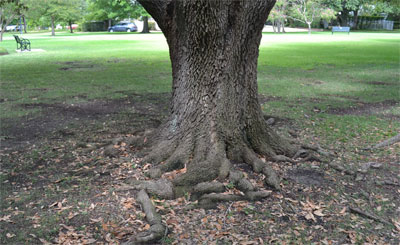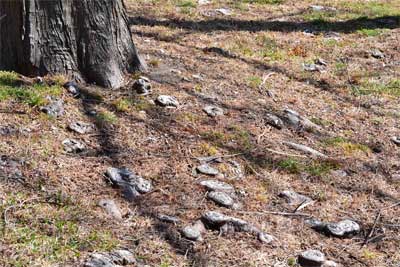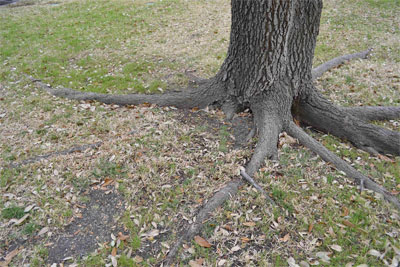Texas Tree Tips – May, 2012

The surface roots from this 50-year-old live oak are both sculptural and challenging. Surface roots can be detrimental to hardscapes. Photos courtesy of Steve Houser.
Surface Roots Can Be a Gardener’s Quandary
Surface roots can be a challenge for even the most experienced gardener. As surface roots increase in size and number and become a menace to the lawn mower blade and the big toe, questions arise. Can surface roots be removed without damaging a tree’s health? How can I work with surface roots and still enjoy my garden? Can I cover surface roots by adding topsoil?

Large surface roots in turf areas can be a nuisance, causing stubbed toes and falls.
There are a number of ways to address surface roots successfully. It is important to understand that a healthy root system is vital to a tree’s health. Roots perform a number of fundamental functions, including the absorption of water and nutrients, transport of those raw materials, anchorage of the tree, and storage of energy for use when needed.
Since more than 80 percent of a tree’s root system can be found in the top 18 inches of soil, it is not unusual for some of those roots to be close enough to the surface that they expand above the soil. Soil erosion can also expose surface roots. Any species of tree can develop surface roots, particularly those planted in shallow soils. Trees that have earned a reputation for problematic surface roots include bald cypress, southern magnolia, cottonwood, and American elm.

The surface roots of bald cypress are often problematic in lawns. Surrounding this tree with an appropriate groundcover would be easier on the eye and the lawn mower.
Arborists always encourage practices that prevent or minimize injury to roots. Cuts to the root system can open entrance courts for root diseases. The loss of root area can also have a devastating impact on tree health. Yet in many ways, the removal of a problematic root is much the same as the removal of a limb or branch.
It is important to consider how many roots may need to be removed. One or two small surface roots removed correctly will not likely affect a tree’s general health. However, damage or removal of more than 25 percent of the root system can have devastating results.
Root pruning before or during our hot summer months should be avoided. The demand a tree places on its root system is highest during these months, and root regeneration is less likely to occur. If roots must be removed, the fall and winter months are best. When roots are removed, they should be cut in a clean, sharp manner. Jagged, torn, and ripped roots will not regenerate new root growth nearly as well as roots with a precise cut.
Covering surface roots is another possible option. This is preferred in many situations when the roots are exposed by soil erosion. Root areas may be covered with 1 to 2 inches of quality, loose topsoil. Some potential drawbacks need to be considered. Do not add soil around the tree’s root flare. The root flare must always remain exposed. Do not add topsoil in such a manner that it changes drainage patterns. Limit the depth of additional soil to 1 to 2 inches. Adding too much soil can deprive the roots of the oxygen they need to function normally.

Erosion has exposed the roots of this Aristocrat pear. They can be covered with a 1 to 2 inch layer of topsoil or mulch.
Often the best solution is to work with nature by leaving the surface roots and converting a turf area to an appropriate groundcover. This approach has particular merit when addressing the persistent knees generated by bald cypresses. Surface roots frequently occur in conjunction with the shade mature trees provide. Dense shade often results in thinning turf. Since trees can be seriously damaged by over-thinning and removing large, low limbs, in an effort to provide more light for the turf, converting the turf to a shade-loving groundcover is a much better long-term solution.

When a growing canopy produces shade-thinned turf and exposed surface roots like these, groundcovers can be a healthy-tree approach to addressing the problem.
Surface roots are not necessarily a gardener’s dilemma. Choose a method of addressing them without negatively affecting the health of your trees. Be forewarned, if you cut too many roots, your tree may become a Harry Potter “Whomping Willow”!!
About the author: Steve Houser is a Dallas native with more than 30 years of experience as a consulting arborist and tree climber. He is the president of Arborilogical Services Inc., “The Experts Your Trees Deserve.” www.arborilogical.com.
